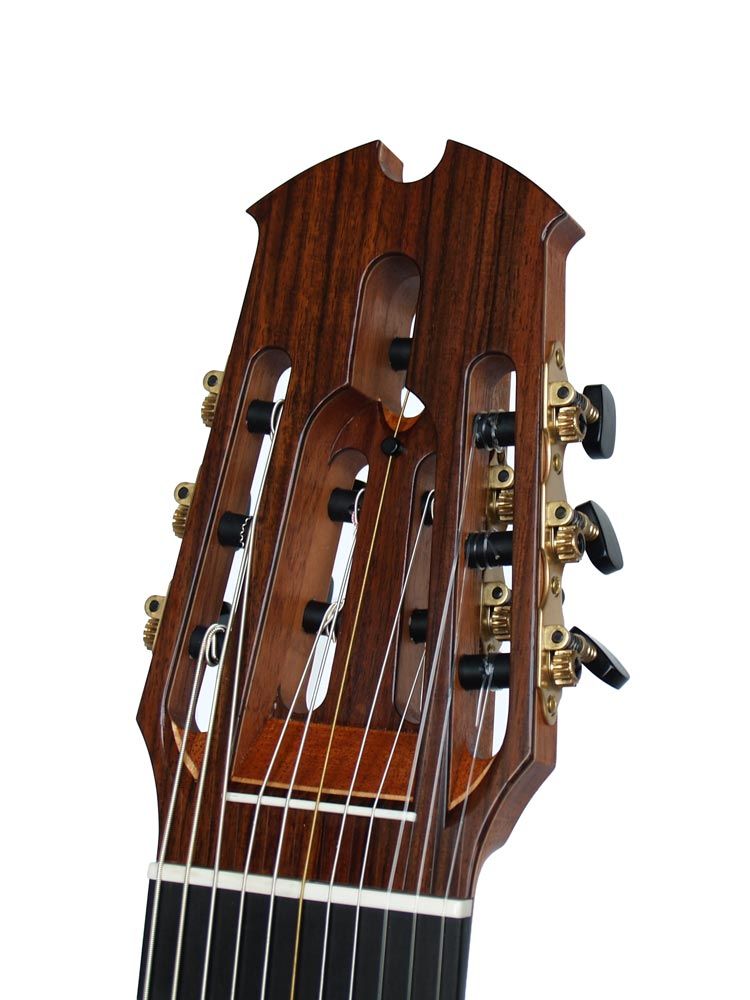11-string Guitar
The unusual position of the soundhole, close to the 12th fret region, supports a more effective transferrence of string energy. The soundboard is slanted, creating additional room for the player's left hand at positions as high up as the 24th fret! This advantage is further enhanced by the careful shaping of the neck and fingerboard profile.
The guitar is equipped with an individual length compensation for each string, allowing for a maximum tuning tolerance of only 2 cent. This instrument features a wide dynamic spectrum, a clear and voluminous sound, excellent balance across its entire range and a rich sonic coloration. Based on the same construction principles as the 6-string model.
The headstock is not much longer or heavier than on a 6string guitar, thus maintaining the instrument's balance. The additional 4 tuners for the bass strings are accommodated by the innovative design, which assures ideal string alignment at the headstock. Even with 11 strings, this instrument's head is not much longer or heavier than on a regular 6-string guitar. This makes for exellent balance. 5 additional tuners are part of this design, still the alignment of each string is achieved without creating strong angles, which would result in tuning and resonance problems. A custom made capodaster has been developped for this guitar, which enables the player to work easily in various tunings. The fingerboard is used in its entire width only on the first three frets. This made it possible to reduce the neck's width in the higher regions. Up until the 12th fret, only 8 of the guitar's 11 strings run over the fingerboard. Above the 12th fret, it becomes continually narrower. This allows for a dramatic weight reduction, which proved to be crucial to maintain overall balance. The soundboard is slanted at an angle toward the fretboard. This creates better handling in the region above the 12th fret, where the left hand's thumb can no longer be used to provide counter pressure for the fingers. This angle also increases the transferrence of string vibration. The guitar is built using an unusual bracing pattern. This new system offers unparalleled efficiency: The sound shaping forces are provided evenly over the entire surface, granting the highest possible strength combined with a very economic use of material, which is important to keep the overall weight at a minimum. Using this bracing, the top can be built very thinly, thus enhancing its frequency connection with the strings. Using lightweight braces, the loss of energy could be kept amazingly small. The result is a louder sounding guitar which never compromises on versatility.
Replacing the soundhole to the upper portion of the body creates a vibrating surface almost a third larger than on a conventional guitar.
G / A / H / C / D / E / A / d / g / h / e’
Scale length: 650 mm
Top: Swiss Spruce
Back and Sides: Indian rosewood
Neck: Mahogany
Fingerboard: Ebony
Lacquer: French polish
Neck width: Saddle 98 mm; 3th fret 103 mm; 5th fret 76 mm;12th Fret 80 mm
Distance between strings: Saddle E/e 88 mm; Bridge E/e 114 mm
Neck thickness: 1th Fret 22 mm; 9th Fret 24 mm
Neck shape: C
Tuning machine : Alessi, black rollers
Lacquer: Top French polish, Body and Neck special DD-Lacquer
Tuning machine: Rubner, Rodgers
Audiosystem: Boton
Back and sides: Brazilian rosewood; maple bigleaf, quilted, flamed. European maple
Customized neck shape
Left-hander guitar

